11 Online Review Statistics You Need To Know
If you click to purchase a product or service based on our independent recommendations and impartial reviews, we may receive a commission. Learn more
We all pay attention to reviews – both good and bad. For any online business or website, online reviews can mean the difference between a sale and the loss of a customer.
To show just how important reviews are for your business, take a look at some key online ecommerce statistics in 2024:
Key Online Review Statistics To Know In 2024
- 91% of 18-34-year-olds trust online reviews as much as personal recommendations
- 97% of consumers use online reviews when researching a local product or service
- Nearly 88% of users say reviews have an impact on their purchasing decisions
- If a product has just 5 reviews, its chances of being purchased increase by 270%
- Before consumers will believe a product’s average star rating, they’ll first want to see an average of 40 online reviews
- 94% say an online review has convinced them to avoid a business
- Only 13% of shoppers will consider using a business with a rating of 2 stars or less
- 92% of B2B buyers are more likely to make a purchase after reading a trusted review
- Customers are likely to spend 31% more on a business with excellent reviews
- 85% of consumers think that any online review over three months old is no longer relevant
- 89% of people read how a business responds to reviews
But how impactful can reviews really be? Should you be worried about fake reviews? Why are Gen Z and millennials so important? We’ll explore all of this and more in the sections ahead.
Why Do Customers Leave Reviews Online?
The importance of online reviews is evident, but why do customers decide to leave reviews about a business, product, or service?
It’s simple. As consumers, we trust what other customers say about the product we’re interested in buying and look for reassurance.
So, by leaving a review online, we contribute to this cycle of information and help future customers make better buying decisions. Ultimately, reviews can convince someone to buy something they like, or they can have the opposite effect and warn a customer off the purchase altogether.
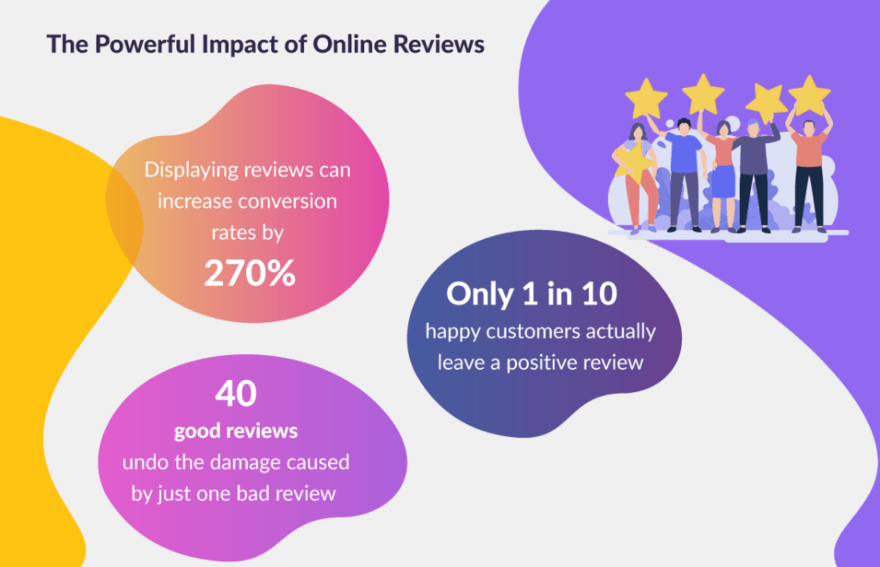
88% of customers say online reviews influence their buying decisions, but they can also help customers feel more engaged and connected with a brand. Building trust with customers is an important step for every ecommerce business, and reviews are just one way to bridge the gap between a buyer and seller.
In fact, one of the key reasons a customer might trust a brand depends on if they have positive customer reviews or not.
What Are Positive Reviews Worth?
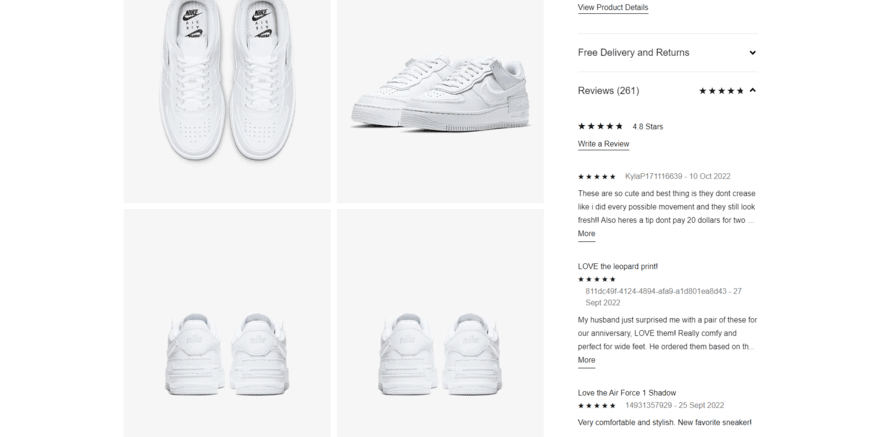
Positive online reviews are sought after by every business and for good reason. They can:
- Boost customer loyalty
- Encourage more sales
- Build brand trust and awareness
- Establish communication channels with customers
Though many people tend to leave reviews directly on a brand’s website, other customers seek reassurance from alternative sites, such as Google, Yelp, Facebook, and Trustpilot. 81% of consumers used Google as a review platform for local businesses in 2021 – more than ever before! And, of course, social media is a huge resource for reviews and customer feedback.

Ultimately, the goal of gathering positive reviews is to boost the online reputation of your business. A happy customer in the US will share their positive experience with 11 additional people. That’s 11 potential new customers!
Plus, it’s been proven that having more reviews is key to boosting your conversions. If a product has just five reviews, the chance of a customer purchasing it increases by a staggering 270%.
A company with 3.3 stars out of 5 is seen to be the minimum rating a customer looks for when choosing to engage with a business – anything less and your business could be overlooked. Unsurprisingly, only 13% of shoppers will consider using a business with a rating of 2 stars or less, so building a solid base of positive reviews is key.
What Is the Impact of Negative Reviews?
We’ve seen how impactful positive reviews can be for an online business or website, but negative reviews are equally as powerful. Your business could be hit with:
- Loss of sales and revenue
- Less referrals
- An opportunity to communicate with customers and improve negatives
In fact, 4 out of 5 customers have decided against buying a recommended product after reading a bad review online, and 94% have been convinced to avoid a business altogether after a negative review.
These are big losses that could be avoided – a business could end up losing 22% of customers because of a single negative review, and a one-star rating decrease could result in a 5-9% revenue loss. We obviously don’t want that!
But negative reviews aren’t all bad, even if they feel like a hit to your brand. Just think of the positives. They’re a great way to gather insight into how some of your customers feel about your business and products, and negative reviews can inspire useful actions.
The most important thing to do with negative reviews, though, is to ensure your business replies to them in a polite, helpful way. Your aim should be to resolve customer issues, respect their concerns, and show any current or potential customers that the business listens. Negative reviews aren’t about starting arguments!

Beware of Fake Reviews
No one trusts a liar and this is truly the era of fake news. In the past year alone, 62% of people believe they’ve seen a fake review for a local business – they’re everywhere!
It might be pranksters looking to damage the reputation of a business, a competitor wanting to appear higher in the search engines, a member of staff hoping to boost the company’s appearance online, or maybe an unhappy customer with a grudge.
It can be easier to manage fake reviews on your website, but it gets a little trickier when the feedback comes from alternative review pages.
Now, if you get bombarded with a bunch of positive fake reviews, that might seem great at first. But, in the long run, they can make your business appear untrustworthy and dishonest which is something you should avoid at all costs.
Interestingly, 68% of consumers wouldn’t trust a 5-star rated website unless it had a high number of authentic reviews to back it up. Customers can be cautious!
On the other hand, if your business gets harassed with a ton of negative fake reviews, alarm bells start ringing for any store owner. We’ve shared online review statistics that highlight the impact of negative reviews already, so make sure you manage your reviews and comments regularly to avoid being overwhelmed by any fake negative reviews too.
Generational Review Stats
One thing you should be aware of is the difference between generations when it comes to shopping online and leaving reviews. Gen Zs, millennials, the Gen X population, and boomers all operate uniquely online. You must understand how to use online reviews to your benefit and market to different generations effectively.
Gen Z & Millennials
For the Gen Z and millennial age group (16-34-year-olds), online reviews are an incredibly important part of the shopping experience and one they contribute to greatly. Building a connection with a brand is key for this audience.
Out of all the generations, Gen Zs and millennials leave the most reviews online, but they take the longest amount of time to feel confident in their buying decision. Not only do they check out their available options thoroughly, but they put a lot of faith in the opinions of other shoppers – and influencers.
Take a look at some key online review stats for this demographic:
- 18 minutes are spent browsing and reading reviews ahead of making a purchase
- The majority need a business to have a minimum star rating of 3 out of 5
- Over a third trust a brand more after an influencer collaboration
- 91% of 18-34 year olds trust online reviews as much as personal recommendations
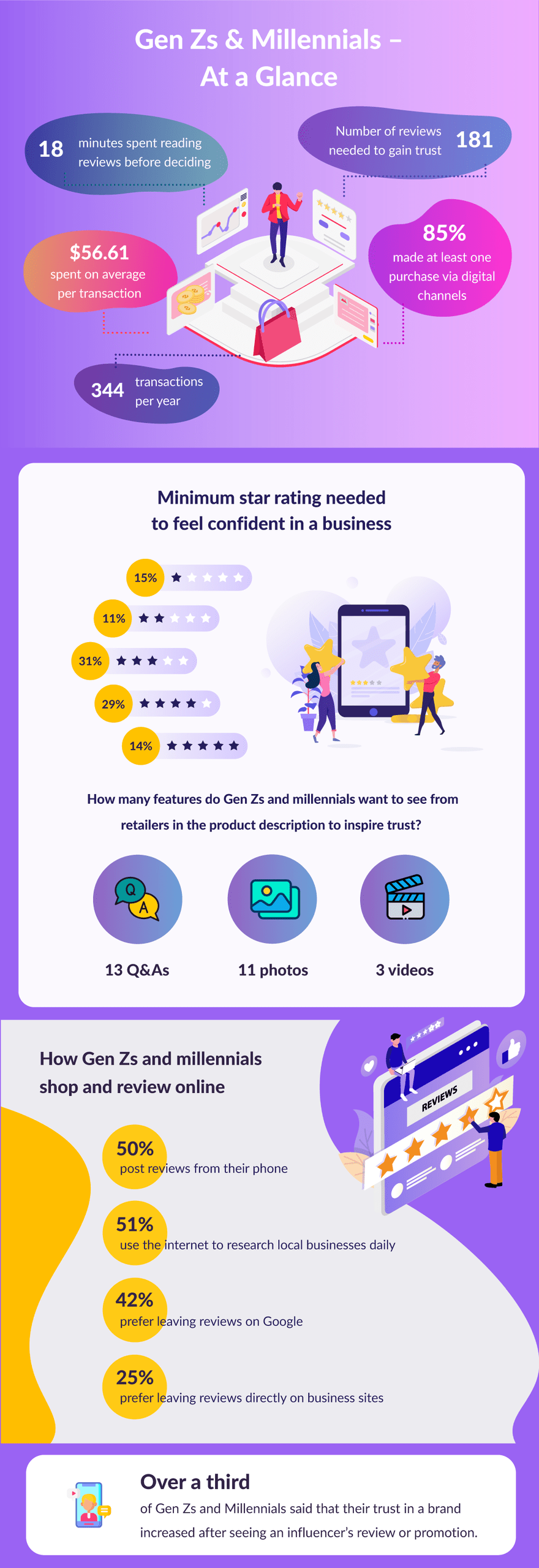
Gen X
In comparison to Gen Z and millennials, Gen X (35-55-year-olds) is a generally more trusting age group and a high-value customer base that’s often overlooked. They’re a good middle-ground between the other two generations – Gen X are regular shoppers that spend almost as much as boomers, are easier to win over than the youngsters, and they’re more tech-savvy than their older counterparts.
Here are some important review statistics you should know about Gen X:
- Gen X spend an average of 13 minutes reading reviews before buying
- 40% post reviews from their phone
- Expect to see more product videos than any other generation
- 46% of the Gen X population research local businesses every day
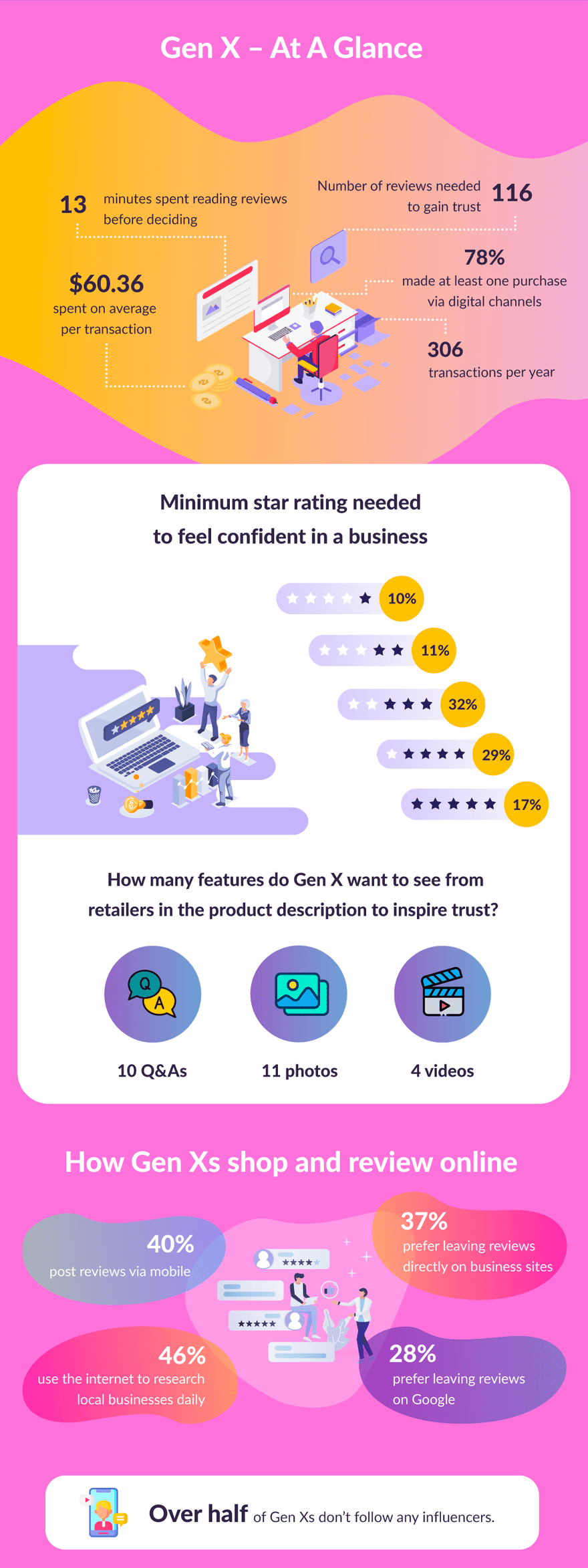
Boomers
Boomers (+55-year-olds) are the most loyal and trustworthy customers, placing less weight on online reviews and greater emphasis on the brand as a whole. This generation doesn’t shop around websites as much as younger generations, and they make fewer purchases online. After all, boomers tend to be a little less experienced online, and they prefer traditional marketing methods. But they do spend more with each transaction on average, so it’s important to tap into this market.
See below for some online review statistics in regards to boomers:
- Boomers spend less than 10 minutes reading reviews before buying
- 7% of boomers would try a business with 1-2 stars
- 48% expect a minimum star rating of 4 stars ahead of buying from a business
- 4 out of 5 boomers don’t know what an influencer is
Advice from the Experts
Top Tip: If you want to gain the trust of the 55+ generation, you’ll need to become an established brand. Boomers are less likely to purchase anything from a business with a low rating, and since boomers generally act faster online, they’re more likely to shop with a reliable and recognizable brand.
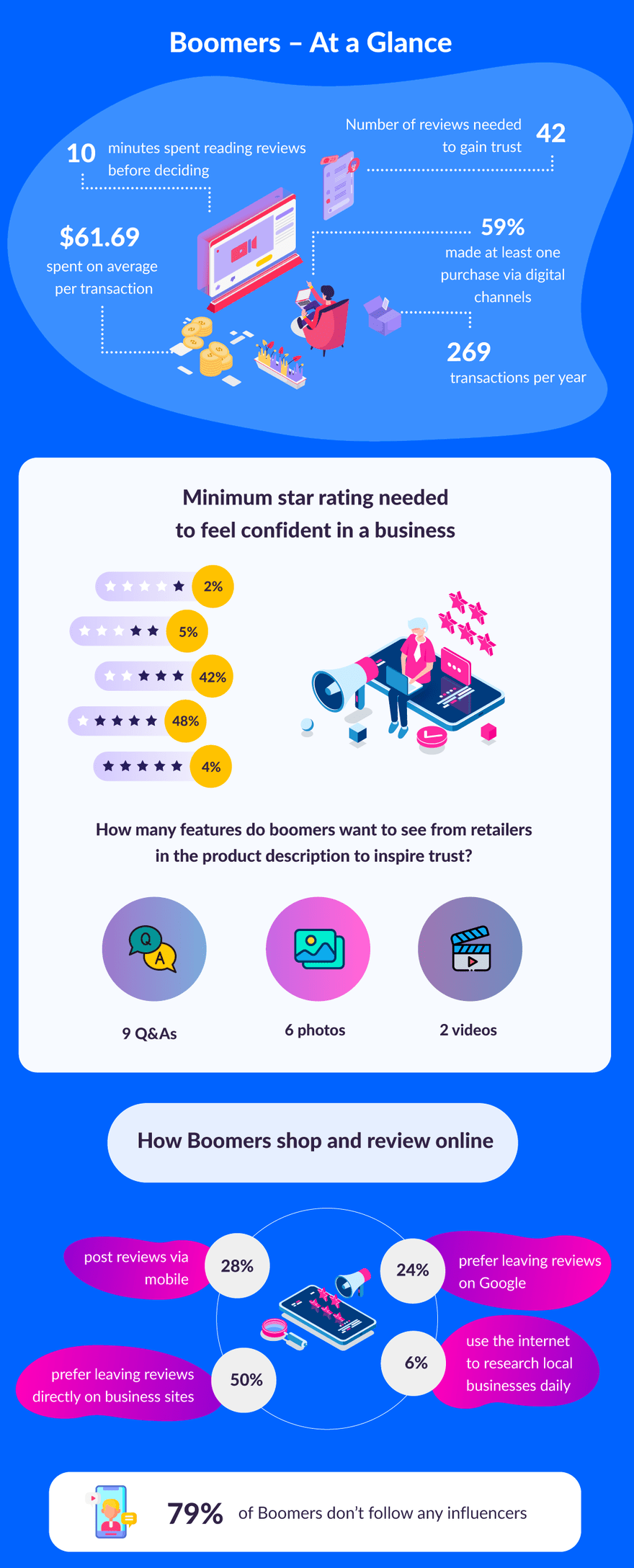
How To Market to Different Generations
Building up a strong star rating is clearly an important milestone for any business since we can see how big of an impact it has across every generation. Knowing their differences, how do you market to them all? Of course, you can tailor your marketing strategies to specific age groups if that suits your business best, but if you don’t want to exclude anyone, check out our expert tips on marketing to different generations:
- Accept reviews across multiple devices and platforms
- Use influencer marketing to target younger audiences
- Invest in SEO
- Stay active across social media
- Be honest and transparent
Tips to Encourage More Reviews
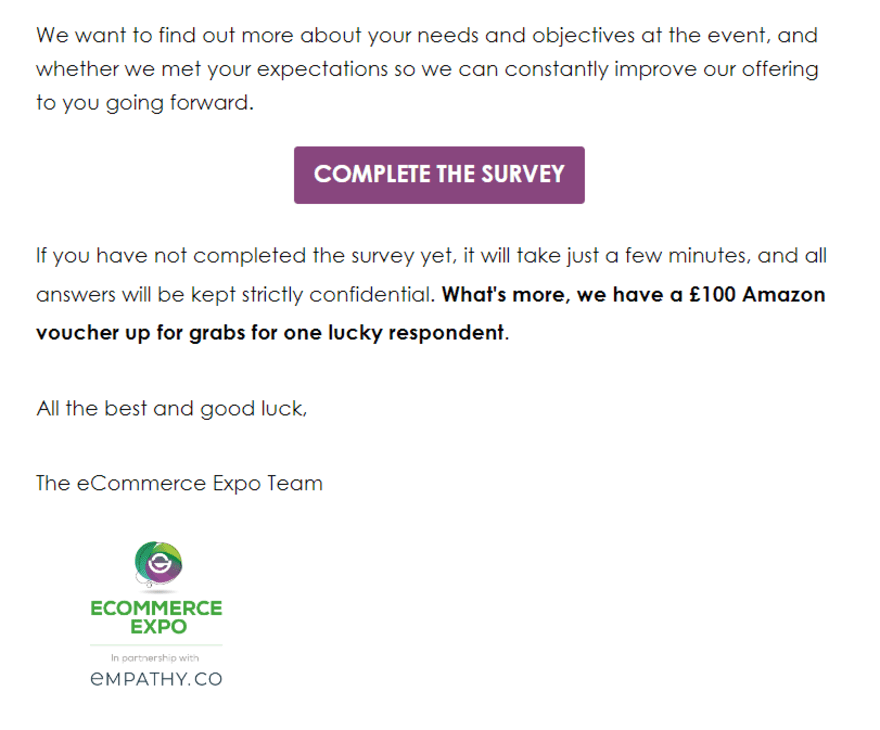
Now you understand the importance and impact of online reviews, it’s worth picking up a few tips to encourage conversations with your customers. We’ve looked at the marketing steps you can take to target different generations, but let’s explore how you can encourage more feedback, retain customers, and encourage new shoppers.
It’s important to have a consistent feed of reviews at all times – 85% of consumers feel that any online review over three months old is no longer relevant. Plus, customers want to read around 40 reviews before they’ll believe a product’s average star rating. This means you need to keep things fresh and make sure you have a plentiful supply of new reviews coming in!
So what can you do to get more reviews online?
#1. Incentivize Your Customers
People love rewards – think prizes, special discount codes, points, or personalized treats. In fact, 75% of consumers favor businesses with reward schemes. Of course, you don’t want to cross the line towards bribery, but encouraging your customers to leave reviews with innocent rewards is a great strategy. You’re not only asking for good reviews but negative ones too, which shows a level of transparency and trust between customers and the business.
#2. Make It Easy To Leave Reviews
One of the most important ways you can encourage more reviews is by making it easy for customers to share their feedback online. Most website builders have usable review or contact form elements that you can add to your pages, and there are plenty of tools to ensure your website is optimized for mobile use. After all, 50% of Gen Zs and millennials share reviews via their phones, and 95% of Gen Xs use phones to connect and search online. And don’t forget alternative review channels like Google, Yelp, or social media apps.
#3. Open Up Multiple Channels of Communication
You can also make it easier to leave reviews by opening up multiple lines of communication with your target audience. This falls hand-in-hand with our previous point to encourage reviews. It’s important to offer your customers different avenues for feedback since some might prefer to leave a review directly on the business website (especially boomers), or send a more casual note on social media.
#4. Use Email Marketing To Follow Up With Customers
Another strategy you can use to encourage more reviews is to send a follow-up to customers after they’ve made a purchase. Not only is this a great way to remind customers about your business – around 80% of companies rely on email marketing to retain clients – but it’s a useful tool to request feedback about a product or the general customer experience.
#5. Share Surveys With Your Audience
Similarly to email marketing, sharing surveys with customers is another great way to request reviews online. On average, a little under 25% of consumers respond to email surveys, which might seem small but that’s a large amount of feedback you might’ve not received otherwise. You can send them out via email, include pop-ups on your website, or promote them across social media to get a wide audience involved.
#6. Engage With Your Customers
89% of customers read how a business responds to reviews, and consumers are more likely to use a business that interacts with its audience. On the flip side, 57% of consumers felt they would be put off buying from a business if they didn’t respond to reviews at all, so engaging with your audience should be a crucial part of your business strategy. Ask relevant questions, spark conversations, and interact with customer feedback regularly.
Advice from the Experts
Top Tip: People love to be listened to! If your business visibly responds to feedback, customers will see that their opinions are valued and they’ll be more likely to leave a review in the future.
Key Online Review Statistics: Summary
Gathering feedback through online reviews is a significant part of running an ecommerce business, but it’s also an important element of the shopper experience. Customers trust other customers.
Here’s a quick reminder of some of the key online review statistics we’ve discussed:
Key Online Review Statistics To Know In 2024
- 91% of 18-34-year-olds trust online reviews as much as personal recommendations
- 97% of consumers use online reviews when researching a local product or service
- Nearly 88% of users say reviews have an impact on their purchasing decisions
- If a product has just 5 reviews, its chances of being purchased increase by 270%
- Before consumers will believe a product’s average star rating, they’ll first want to see an average of 40 online reviews
- 94% say an online review has convinced them to avoid a business
- Only 13% of shoppers will consider using a business with a rating of 2 stars or less
- 92% of B2B buyers are more likely to make a purchase after reading a trusted review
- Customers are likely to spend 31% more on a business with excellent reviews
- 85% of consumers think that any online review over three months old is no longer relevant
- 89% of people read how a business responds to reviews
Of course, if you’re encouraging more people to leave reviews, the hope is that they’ll leave positive feedback, but negative reviews are unavoidable and they shouldn’t be brushed aside. As we’ve already said, negative reviews can influence 94% of buyers away from a business. Still, they also offer you valuable insight into how your customers feel which gives you an opportunity to act on the comments.
After all, you want to be a trustworthy brand, and while only having glowing reviews may seem like the dream, in reality it can look a little suspicious. If keeping a comment or online review on your website brings value, and you can interact with it in a positive or constructive way, keep it! You might be able to change their outlook and turn their experience with your business into a positive one.

2 comments